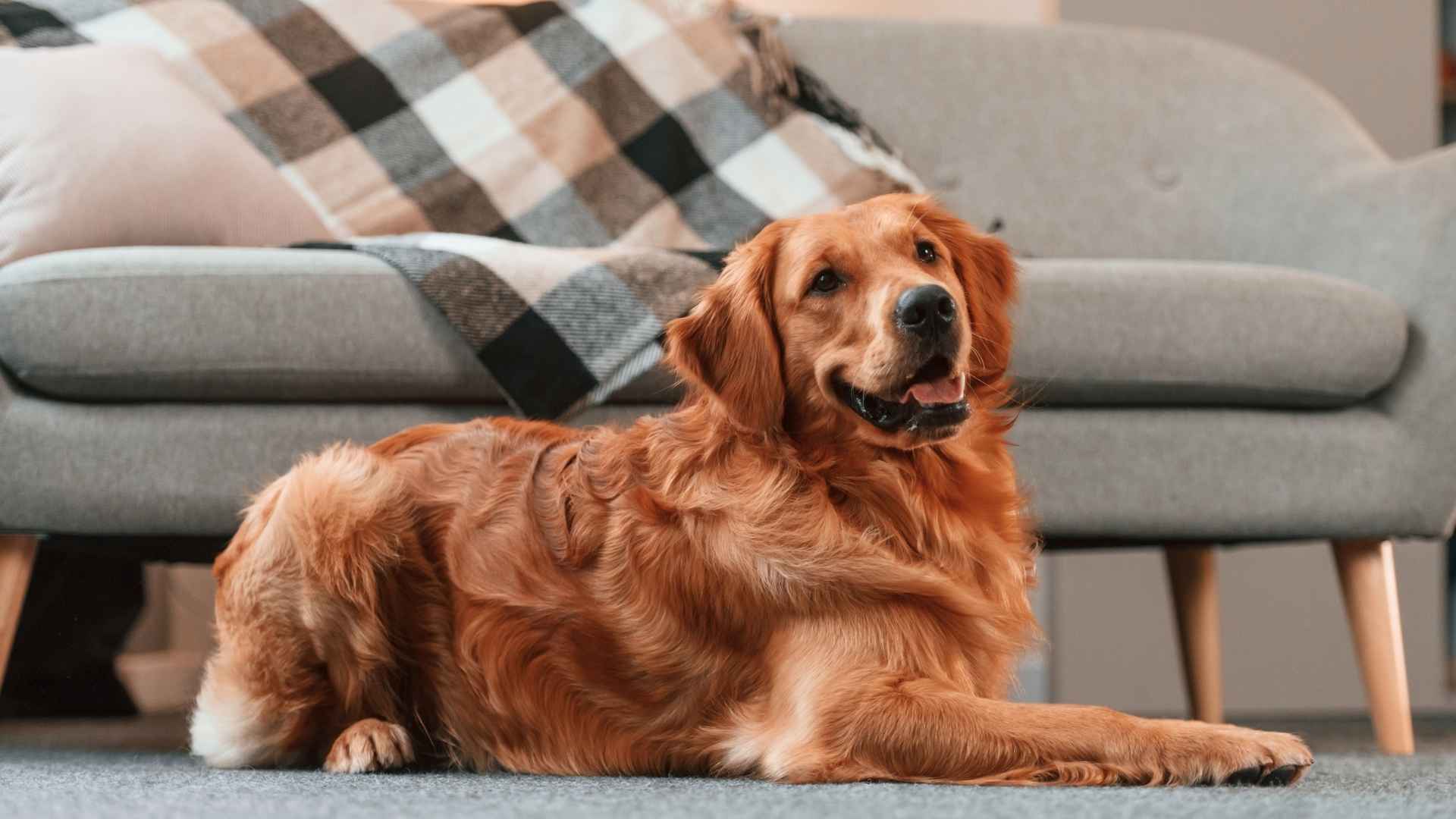Listen up, city-dwelling dog lovers! Just because you’re living in a cozy apartment doesn’t mean you have to give up on your dream of having a furry best friend. Good news: small spaces don’t disqualify you from dog parenthood!
In fact, it’s not the square footage that matters — it’s the quality time you spend with your pup. Dogs crave love, attention, and regular exercise way more than sprawling space. But if you’ve got a busy schedule or simply enjoy a more laid-back vibe, you’ll want to look into independent-minded and apartment-friendly dog breeds.
These are the cool, low-maintenance canine companions that are perfectly content hanging solo while you’re out adulting. Whether you’re living in a bustling studio or a sleek two-bedroom high-rise, we’re here to help you find the paw-fect furry friend for your lifestyle. Ready to meet the mellow pups that thrive in small spaces? Let’s dive in!
Independent Apartment Dog Breeds
1. Greyhound
Graceful, sleek, and surprisingly lazy dog breed, the Greyhound is a breed full of delightful contradictions. Known as the fastest dog on Earth (clocking up to 45 mph!), this ancient aristocrat has roots dating back to Egyptian tombs from 3000 BCE. But don’t let that speed fool you. These sprinters would rather snooze on your sofa than run laps around the dog park.
Despite their race-dog rep, Greyhounds are super low-energy indoors. They thrive on short, brisk walks — just 20 to 30 minutes twice a day does the trick. After that, it’s back to napping like it’s their full-time job. Their independent, cat-like nature makes them a perfect pet for apartment dwellers without much hustle and bustle.
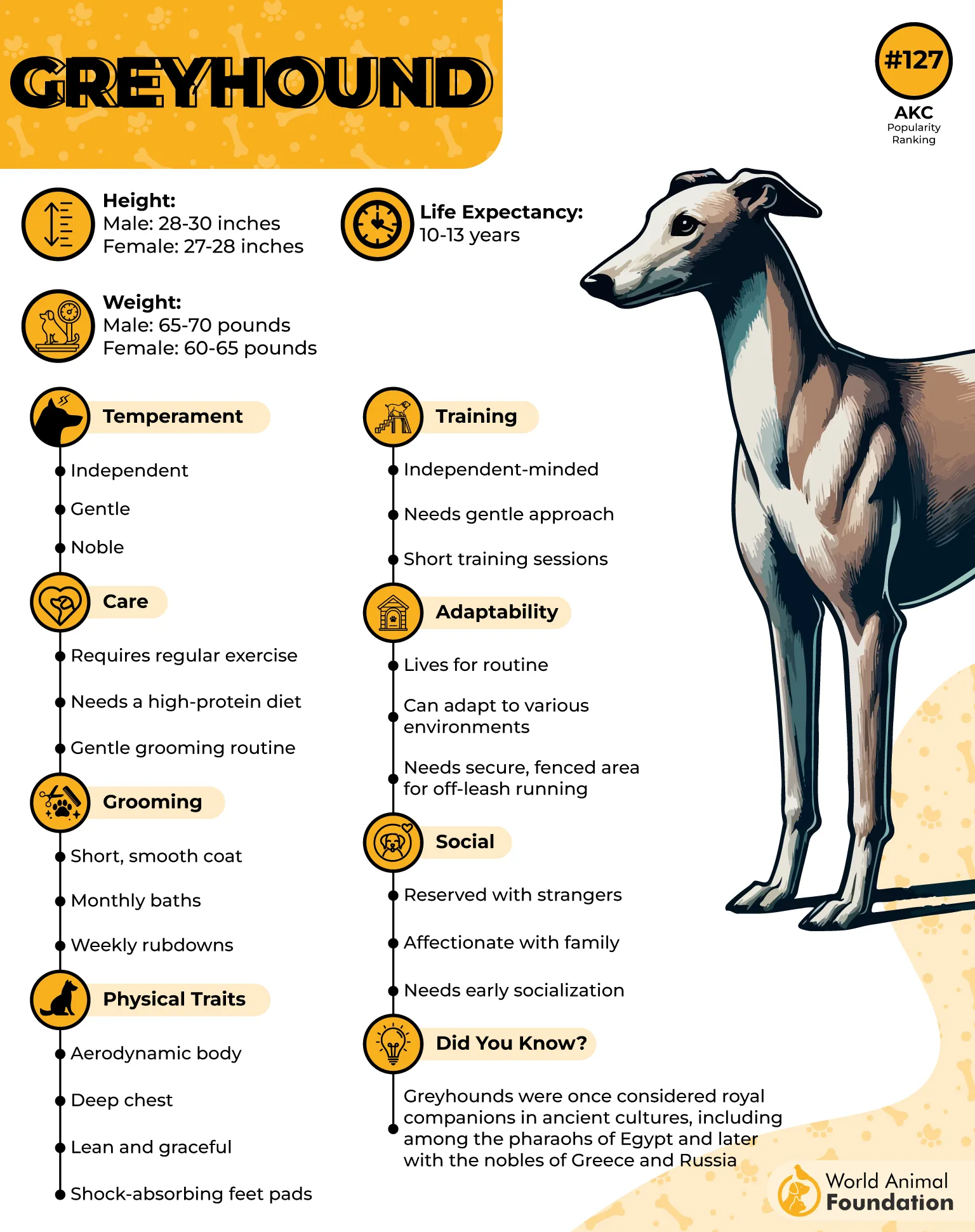
AKC states Greyhounds are sweet-natured, goofy, and full of personality — think gentle giants with a silly streak. Their smooth, short coat means grooming is a breeze, and their extremely affectionate but easygoing nature makes them an absolute joy to have around.
These sensitive souls do best in peaceful homes with older kids and calm energy. While they’re loving with their humans, they can be a little shy around strangers if not well-socialized early on.
Because they were bred to chase, most Greyhounds have a strong prey drive. That means smaller pets like cats, rabbits, or squirrels might trigger their inner racer, so it’s best to keep them on-leash unless you’re in a secure, pet-free area.
Fun Fact: A Legendary Pup
From ancient Egypt to Greek mythology and even the Bible, the Greyhound has been stealing hearts for millennia. Today, they’re still doing it — just from the comfort of your couch.
2. Shar Pei
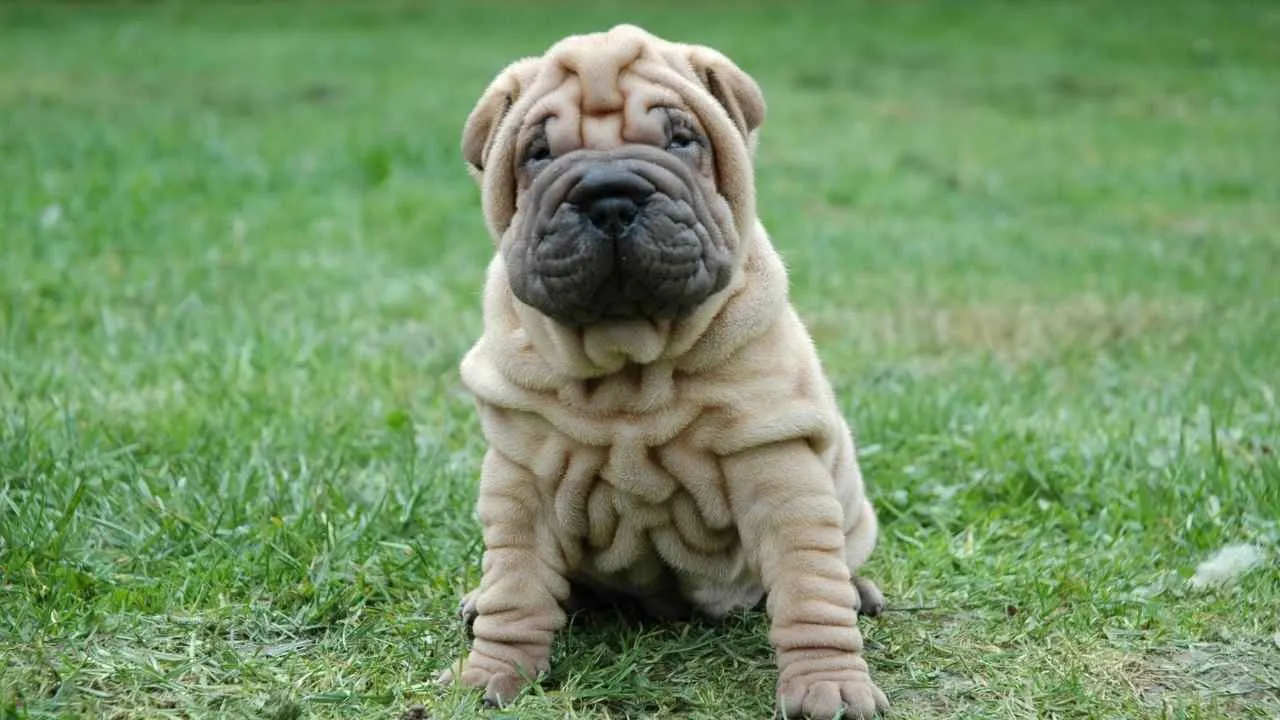
With its signature deep folds, blue-black tongue, and a face that looks part hippo, part philosopher, the Shar-Pei is truly unforgettable. But this ancient Chinese breed isn’t just about looks—it brings a calm, confident presence and a deep-rooted loyalty to its inner circle.
Shar-Peis are undeniably intelligent, but don’t mistake that for eagerness to please. These dogs like to think for themselves. Training calls for a steady hand, early socialization, and positive reinforcement. Win them over, and you’ve got a steadfast sidekick who takes their loyalty seriously.
Despite their medium build (typically 45–60 pounds), Shar-Peis are surprisingly low-key. A couple of brisk walks each day usually do the trick—no need for a backyard or a hyperactive lifestyle. Their independent nature means they handle alone time better than many breeds, making them a great fit for working pet parents.
Shar-Peis form strong bonds with their families but aren’t naturally outgoing with strangers. That cool, composed demeanor isn’t shyness—it’s confidence. With proper guidance and early exposure to new people and places, they can learn to relax in unfamiliar settings. Their natural wariness also makes them top-tier watchdogs—alert, observant, and never over-the-top.
Fun Fact!
Those signature wrinkles aren’t just for looks — they were originally designed to protect Shar-Peis in scuffles. If another dog latched on, they’d just get a mouthful of loose skin while the Shar-Pei slipped away. Smart and stylish, right?
3. Cairn Terrier
With roots tracing back over two centuries to the Isle of Skye and the Scottish Highlands, the Cairn Terrier was built for bravery. Originally bred to flush out vermin from stone piles—or “cairns”—these little dynamos still carry that bold, no-nonsense spirit today.
Cairns are smart, curious, and full of personality. They love to explore and keep themselves busy, often preferring action over endless cuddles. Their independence can come off as stubbornness, but with consistent training, they pick up commands quickly and often surprise you with their cleverness.
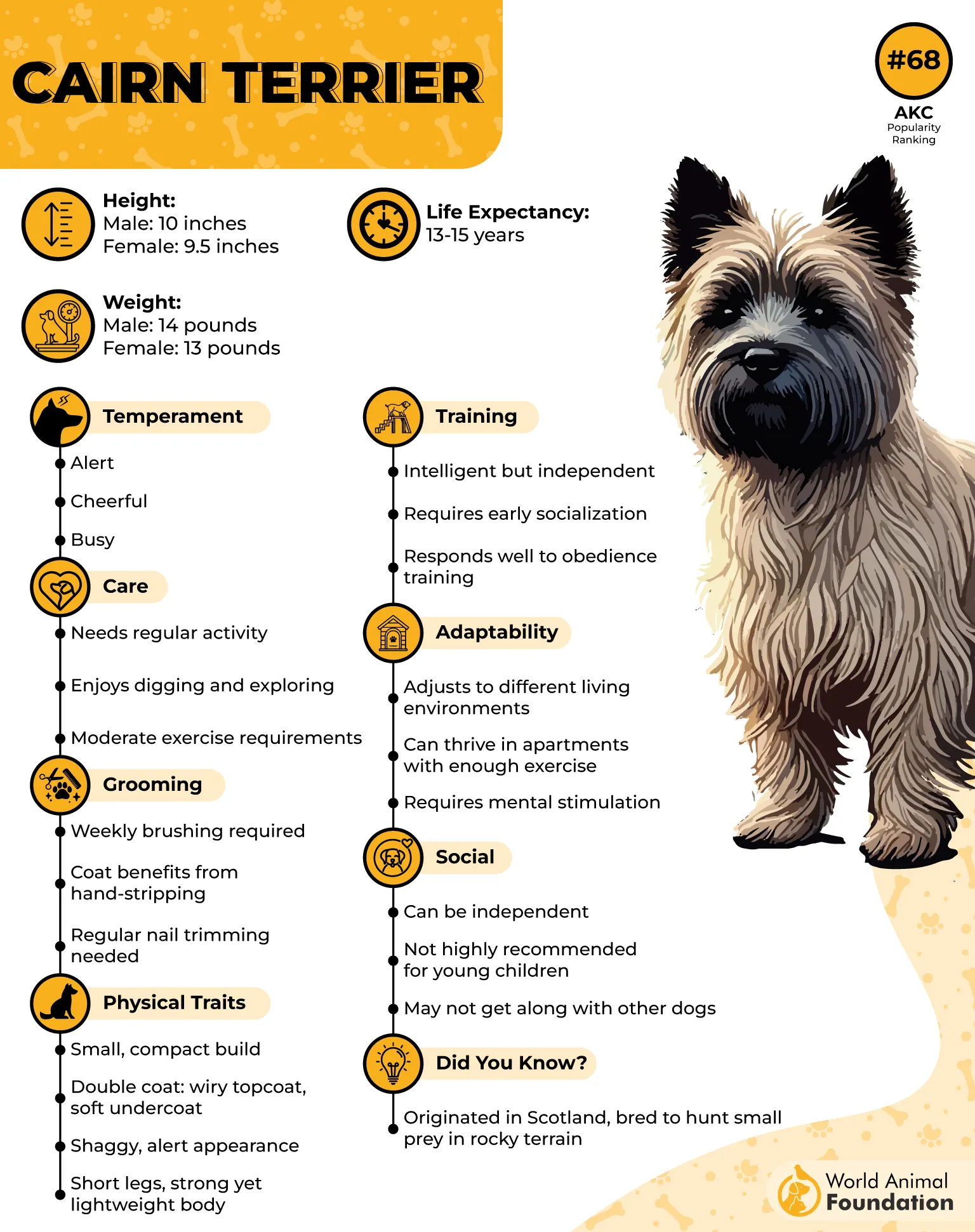
Cairns have a playful personality, and they fit well into family life and usually do great with children. While they tend to be sociable, early socialization helps them stay well-mannered around other pets. Their instinct to chase is strong, so supervision around small animals is a must until trust is built.
Despite their working-dog heritage, Cairns are also well suited for apartment living—just be sure to give them a daily walk and some time to sniff around outdoors. They thrive when they have something to do, whether it is playing fetch, a backyard digging spot, ora puzzle toy, anything that keeps them occupied and satisfied.
Their rugged coat is low-shedding and relatively fuss-free. A few weekly brushes and the occasional bath are usually enough to keep them looking tidy and feeling great. Low maintenance, lively, and full of charm—the Cairn Terrier is small in size but big in heart.
Fun Fact!
Ever seen The Wizard of Oz? Then you’ve met a Cairn Terrier! Toto was the world’s most famous Cairn, proving once and for all that this little dog is full of heart, courage, and just the right amount of sass.
4. Siberian Husky
Siberian Huskies are the true rebels of the dog world—smart, independent, and never ones to follow orders just for the sake of it. Training them takes patience and creativity because “just because I said so” won’t cut it. These clever pups respond best when they’re convinced that listening is in their own best interest.
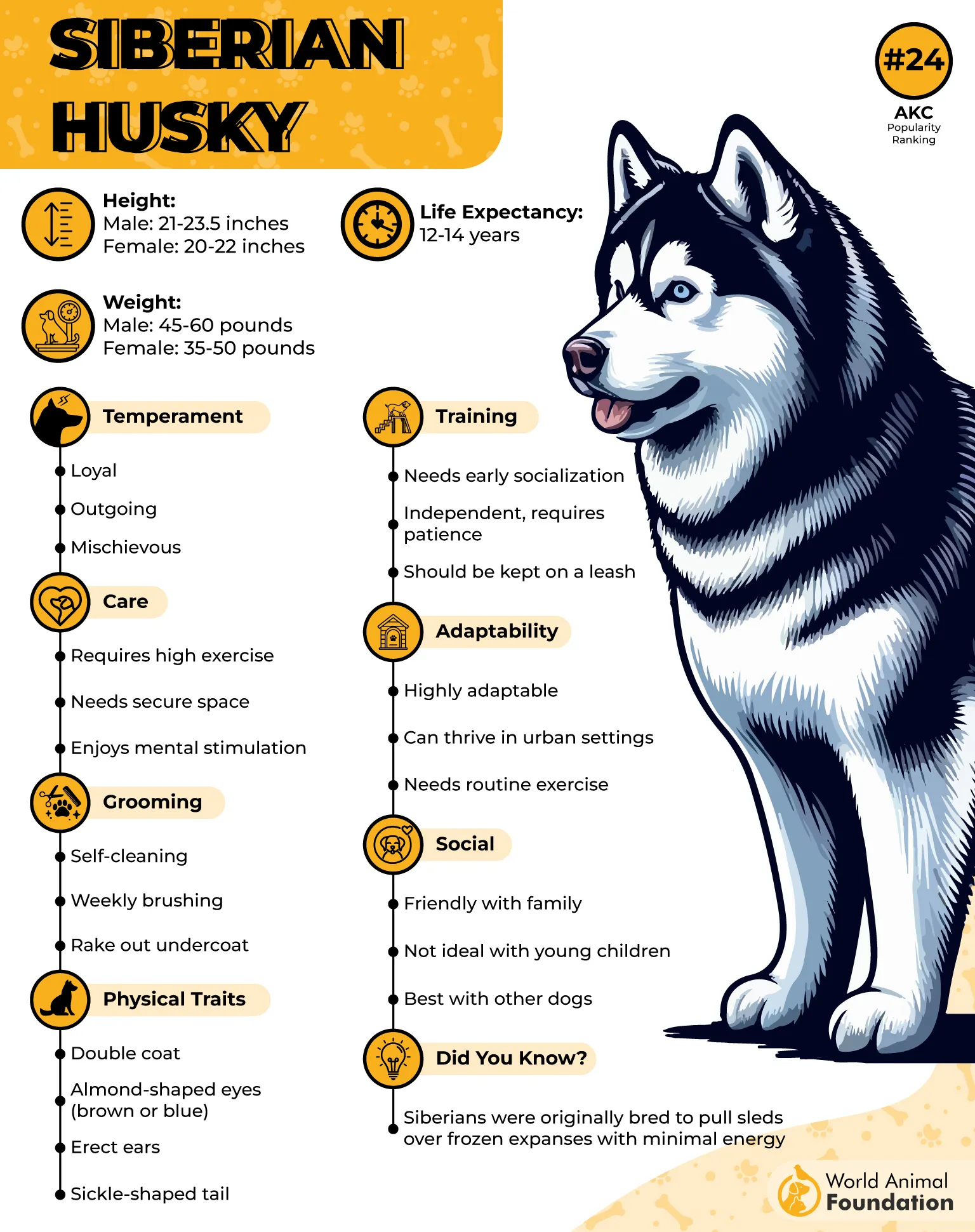
Though they march to the beat of their own drum, Siberian Huskies are social butterflies who love being part of a pack, whether that’s with humans or other dogs. But don’t be fooled by their friendly nature; they have a streak of stubbornness that demands early and consistent training, especially if you’re in an apartment. And be prepared for their signature vocalizations—howls, whines, and even the occasional husky “chat.”
Living in an apartment with a Husky is doable but requires dedication. Britannica states these high-energy dogs need adequate exercise—think long walks, vigorous play, and safe spaces to roam. Without enough outlets for their energy, they may turn to mischief, which often means chewed shoes or scratched floors.

While adaptable, Huskies are medium to large-sized and need room to stretch out indoors, too. A cozy bed, a spot for meals, and enough space for indoor playtime help keep them happy and calm. Cramped quarters can quickly lead to a frustrated pup, destructive behavior, and a stressed dog owner.
As for their vocal flair, Huskies don’t just bark; they perform! Howling and whining are part of their charm, so you may get noise complaints from neighbors. The key to a quieter side is proper training, plenty of mental challenges, and physical activity—because a tired Husky is a well-behaved (and quieter) Husky.
Fun Fact:
Huskies come with a built-in urge to excavate. And no, we’re not exaggerating — they’ll dig craters if given the chance. Whether it’s your flower bed or your bed-bed (yes, the one with the fancy comforter), a bored Husky might just go digging for buried treasure. A designated digging spot or sandbox can help satisfy this instinct without wrecking your space.
5. Scottish Terrier
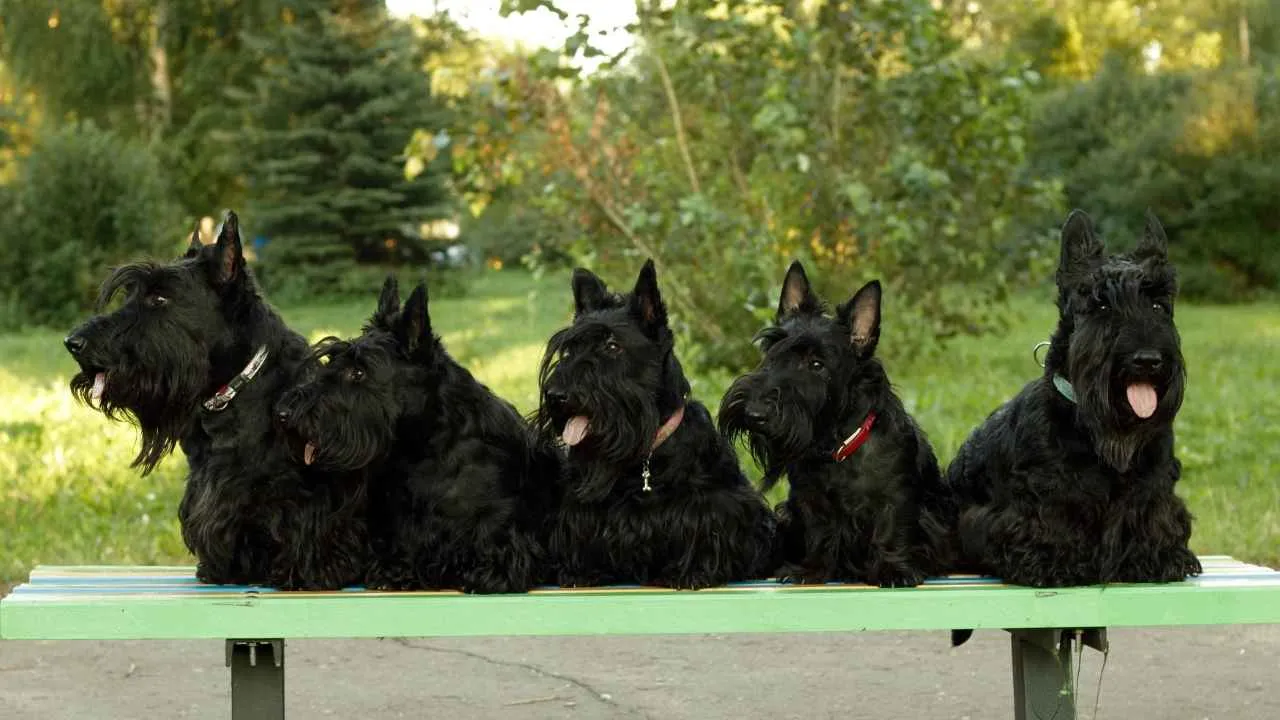
The Scottish Terrier, or Scottie, is a small dog breed with a big personality and independence. Known as “The Diehard,” this breed’s confident, determined nature comes from its history of hunting foxes and badgers. That bold attitude is still very much alive today.
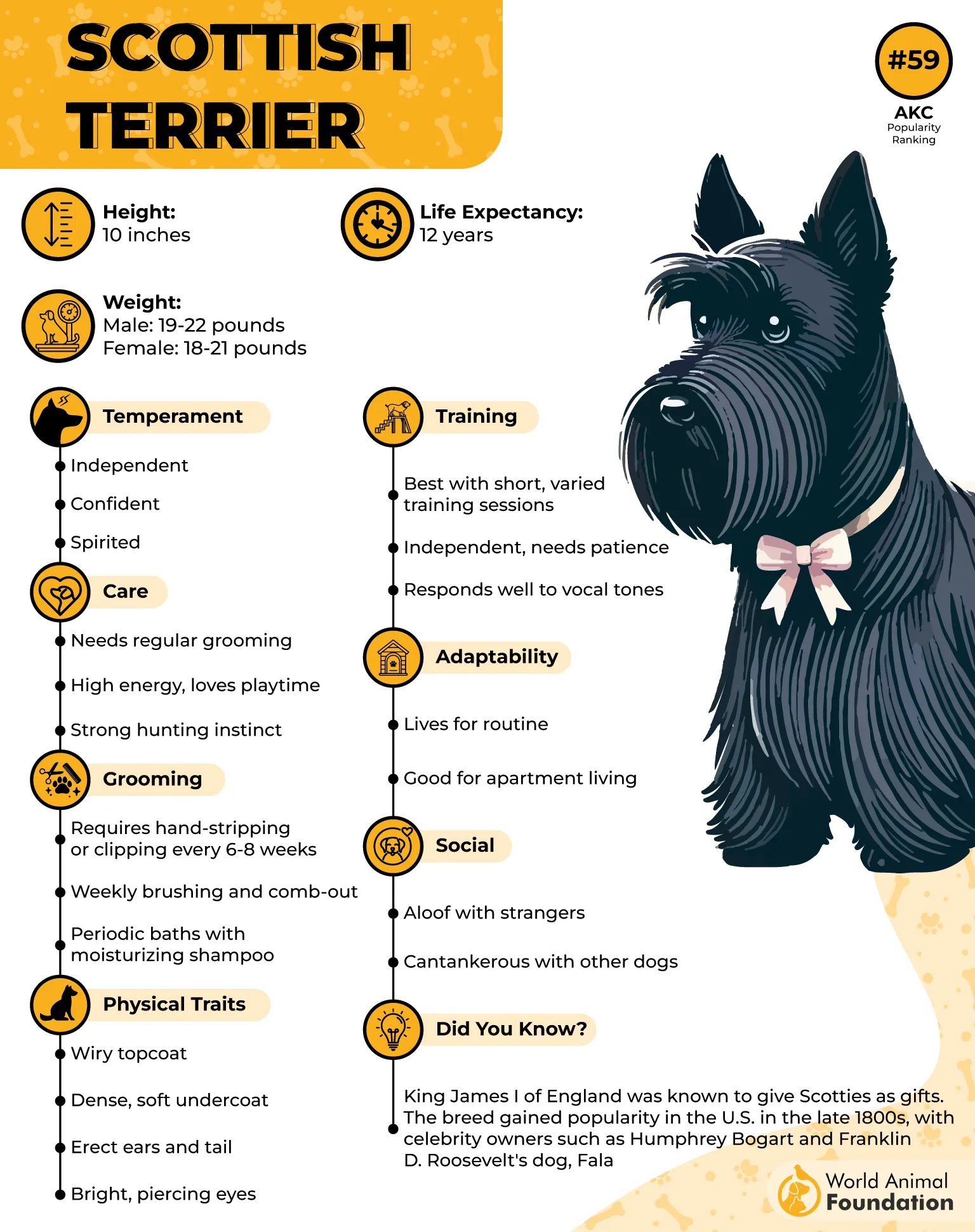
Scotties carry a dignified air and are fiercely loyal to their families. They remember everything—especially the things you’d rather they forget. Training takes patience since they need to see a good reason to follow commands, but once they commit, they’re brave and dependable companions.
These dogs do best with families who understand their playful yet stand-your-ground attitude. They’re not overly cuddly but make excellent watchdogs, barking with purpose and plenty of volume when needed.
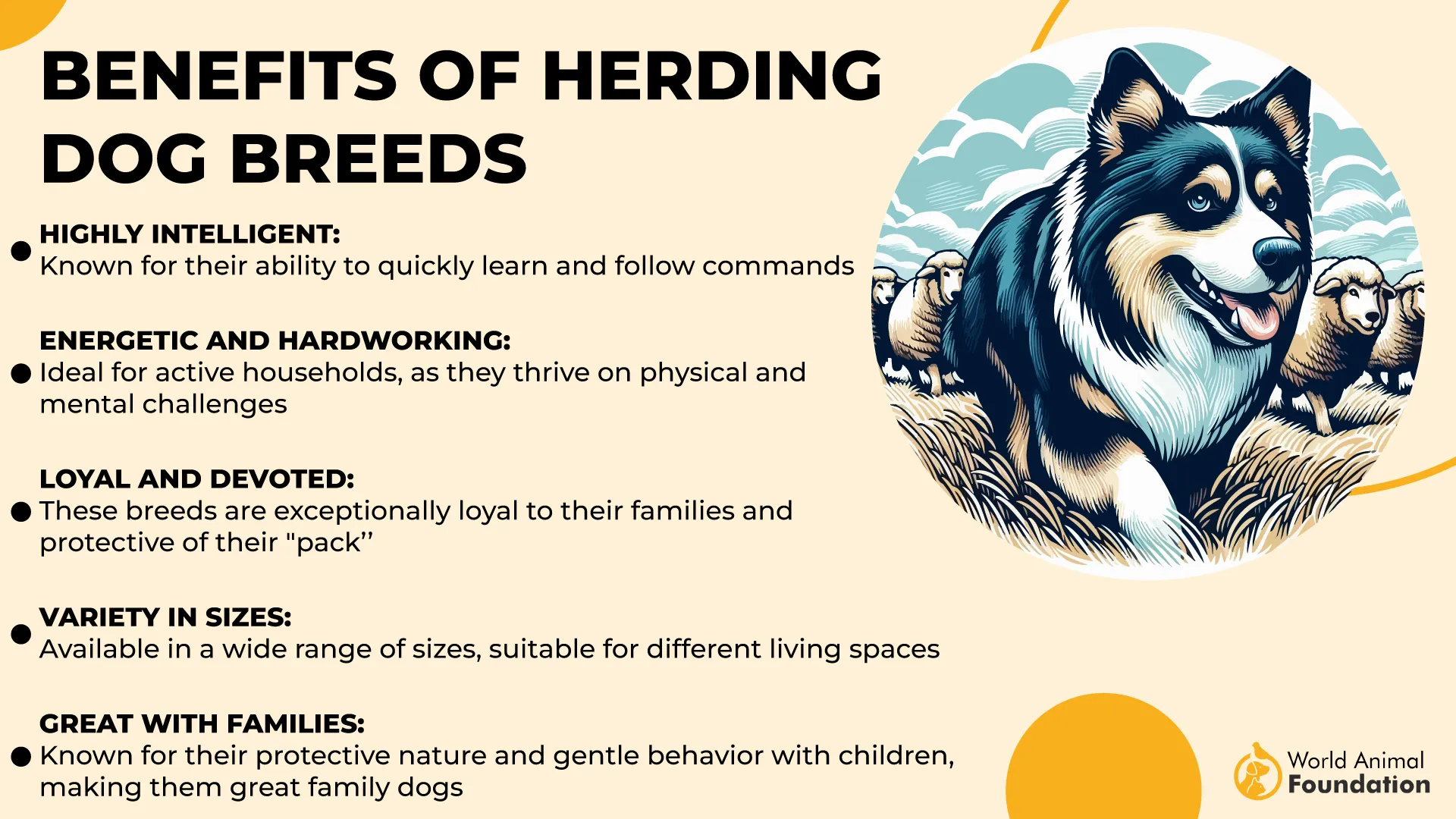
Scotties thrive when given a job or a challenge. They love to dig, chase, and patrol, so early training is important to keep those instincts in check. Daily walks, playtime, and mental stimulation like puzzle toys or dog sports keep their energy balanced.
Whether in a small apartment or a house with a yard, Scotties can adapt well if given routine and exercise. Their alert nature means they’ll let you know when strangers or even squirrels are nearby, so regular outings and a secure space are essential.
One thing to note:
Swimming is not a Scottie specialty. Their build—short legs and a top-heavy frame—makes them clumsy in water, and they can easily get into trouble near pools or ponds. Always supervise them near water, and skip the doggy pool party invites.
6. Chow Chow
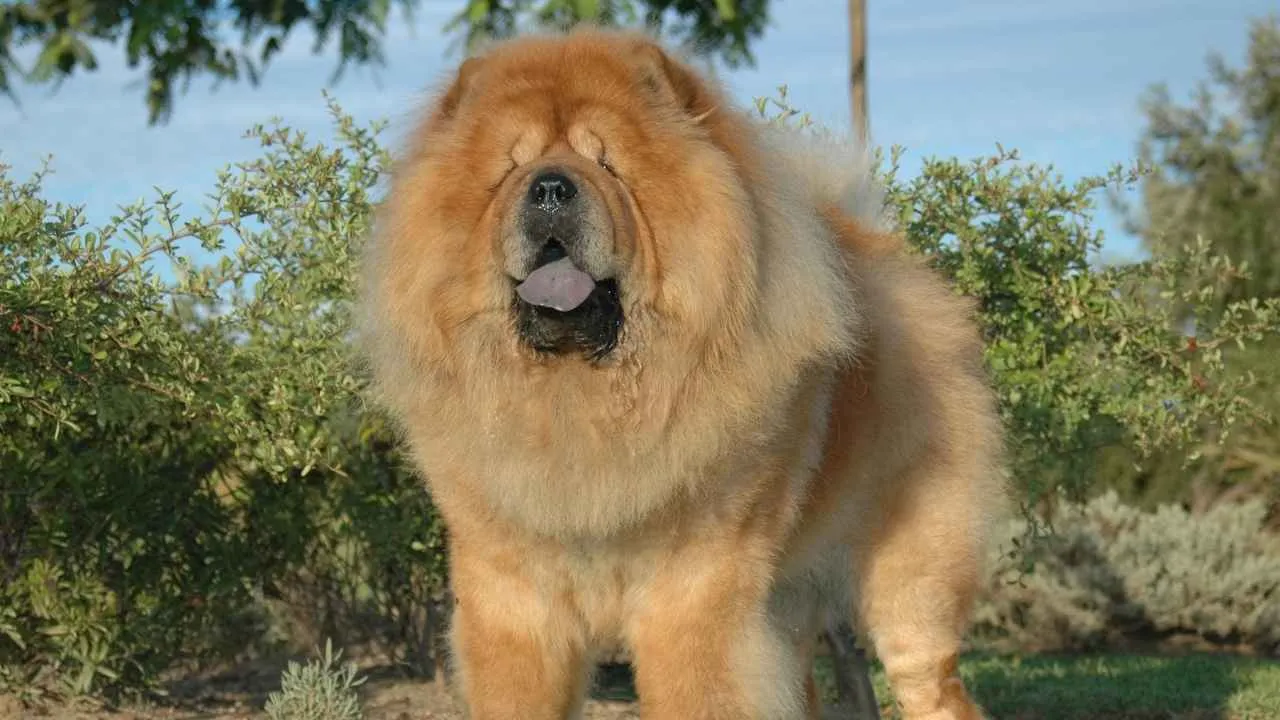
With its lion-like mane, deep-set eyes, and distinctive blue-black tongue, the Chow Chow looks like a creature from a legend—and in many ways, it is. This ancient breed from China dates back to the Han dynasty and was once used as hunters, guard dogs and and even as a food source. Today, it’s admired for its quiet dignity and strong loyalty to family.

Chow Chows bond deeply with their people but aren’t overly affectionate or clingy. They show love in their own reserved way—often by quietly sitting near you and guarding your space with calm confidence rather than with enthusiastic tail wags or kisses.
Training requires patience since Chows are smart but independent thinkers who prefer doing things their way. With early socialization and positive reinforcement, they become well-behaved companions, but you’ll need to accept a certain stubborn streak in this thoughtful breed.
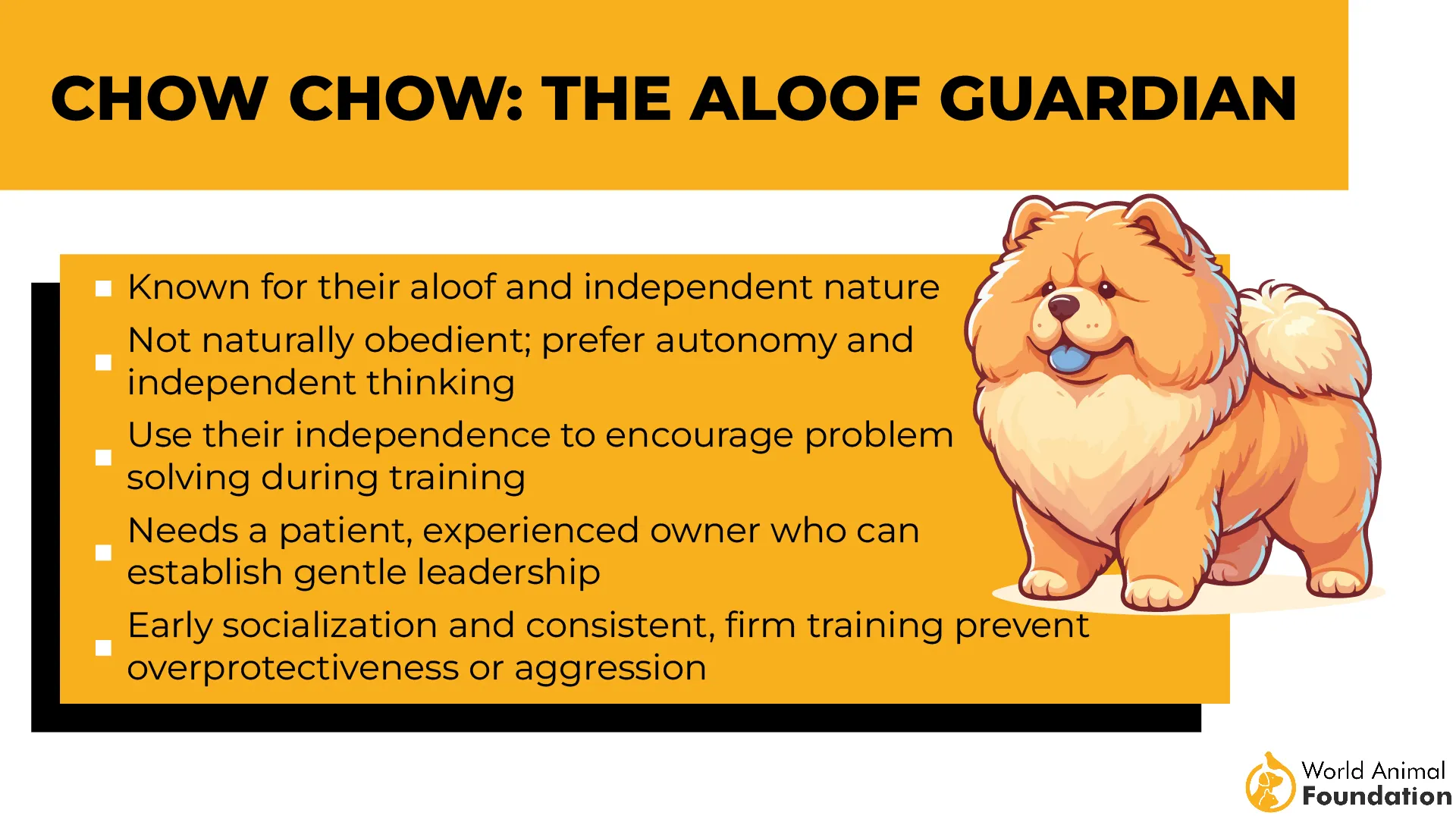
They aren’t the most outgoing dogs and can be reserved around strangers or selective with other dogs, though many get along well with cats and household pets. Their calm, watchful nature makes them excellent watchdogs—they don’t bark incessantly without reason but will alert you if something’s amiss.
Despite their solid build, Chow Chows have moderate energy levels and adapt well to an apartment setting as long as they get daily walks and a cozy spot to relax. They prefer gentle strolls over vigorous exercise and enjoy mental activities like puzzle toys or nose work to stay engaged.
Their thick double coat needs regular grooming, especially during shedding seasons. Although they look ready for winter fun, Chow Chows don’t handle heat well. In warmer weather, provide plenty of shade and air conditioning, and avoid strenuous activity during the hottest parts of the day.
Fun Fact:
Chow Chows are part of a rare group of breeds—like the Chinese Shar-Pei and Thai Ridgeback—that sport blue-black or purplish tongues. This unique coloring comes from high levels of melanin and adds even more mystery to their already majestic appearance.
7. Shih Tzu
Small, regal, and downright adorable, Shih Tzus often look like living plush toys. But beneath that luxurious coat is a dog bursting with spunk, charm, and a surprisingly strong will. Their affectionate and social nature makes them one of the most beloved breeds around.
These little lions come with a rich history. Originating in Tibet and treasured in Chinese courts during the Manchu dynasty, Shih Tzu were once considered sacred protectors. The name means “little lion,” though they’re more about cuddles than roaring. By the early 1900s, they reached Britain and quickly won hearts across Europe.
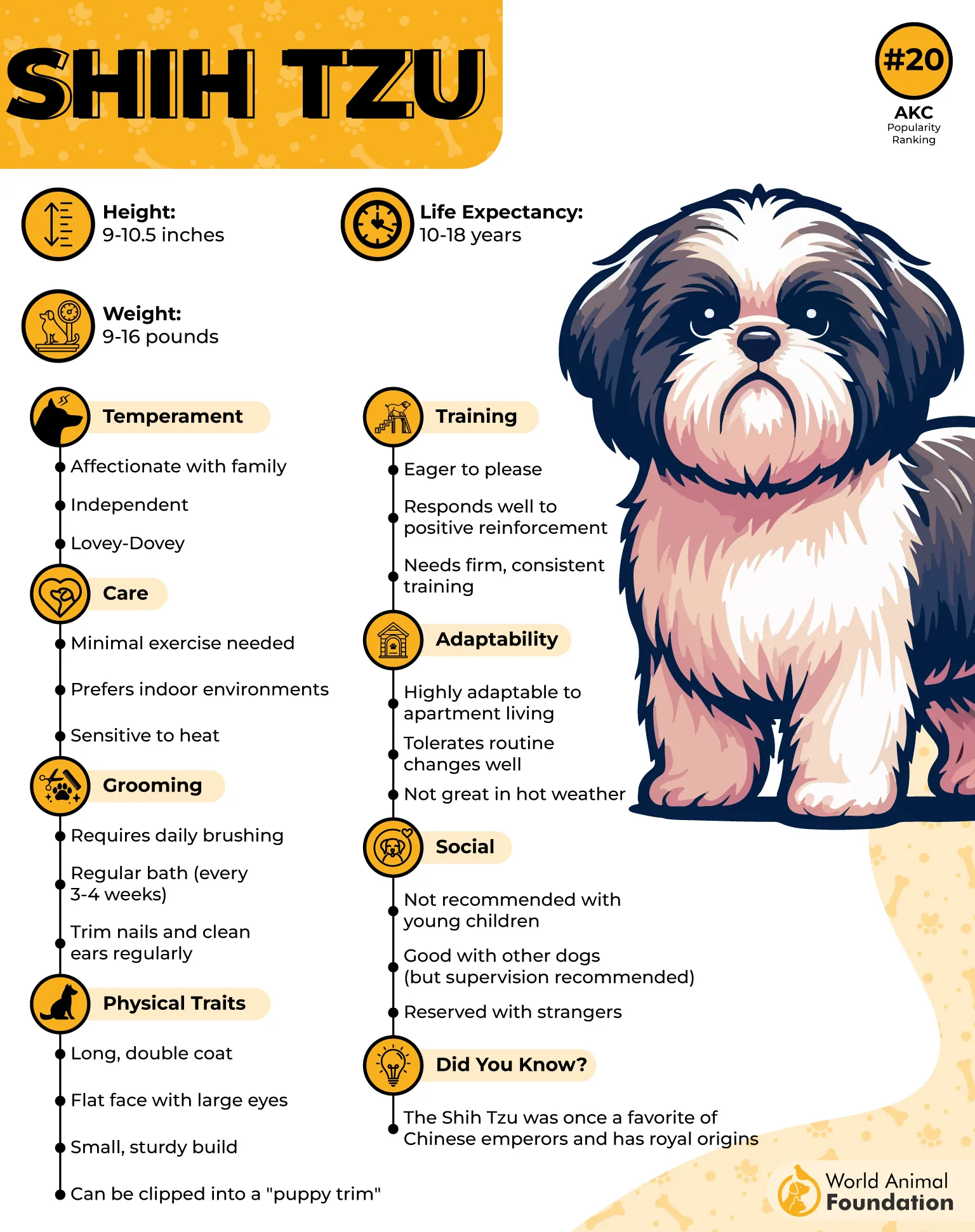
Though devoted, Shih Tzu is independent and clever, especially when treats are involved. They don’t respond well to harsh training, so patience, consistency, and humor are key to guiding their stubborn streak.
Shih Tzus thrive on companionship and dislike being left alone for a long time. Short breaks solo are okay, but they’re happiest when included in the family buzz. If you’re out, enrichment toys or a pet sitter can help keep them happy.
The Shih Tzu is often considered a hypoallergenic dog because its coat tends to trap shed hair and pet dander, helping reduce allergens in the environment. Daily grooming keeps their luxurious coats pristine. This makes them a great choice for people sensitive to pet allergens.
Perfect for apartment living, Shih Tzus are calm, quiet, and great companions who won’t cause a ruckus in small spaces. They enjoy lounging nearby but also appreciate having a cozy spot of their own—a smart solution if space is tight.
Conclusion
Choosing the best apartment dog means finding a balance between size, temperament, and lifestyle. Breeds like the Cavalier King Charles Spaniel, Boston Terrier, Bichon Frise, and French Bulldog are popular for a reason—they’re adaptable, low-shedding, and thrive in smaller living spaces. Even some larger breeds, like the Bernese Mountain Dog or Pit Bull, can adjust well with enough exercise and consistent dog training.
Whether you prefer tiny dogs like Yorkshire Terriers or laid-back breeds like the Italian Greyhound, the key is matching their exercise needs to your daily routine. Many great apartment pets are house-trained, need only low exercise, and are content in a studio apartment or apartment building.
With so many dog breeds out there, choosing the right dog means considering more than just size—think grooming, energy levels, and how much time you can give. Get it right, and you’ll have more than just a pet—you’ll have a great companion.


